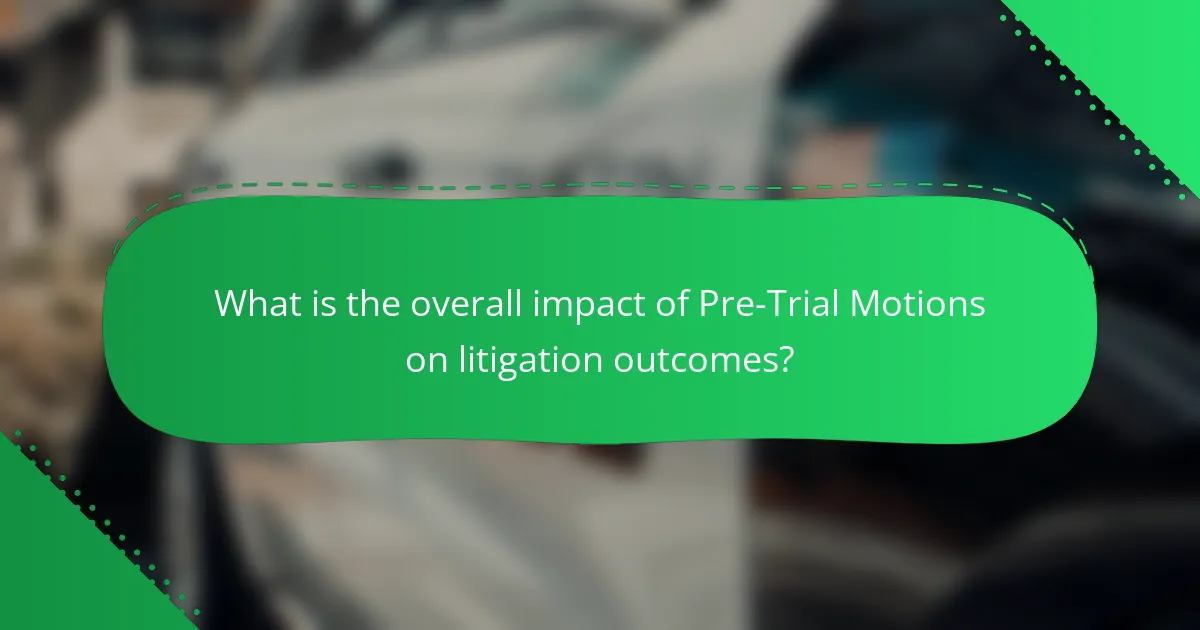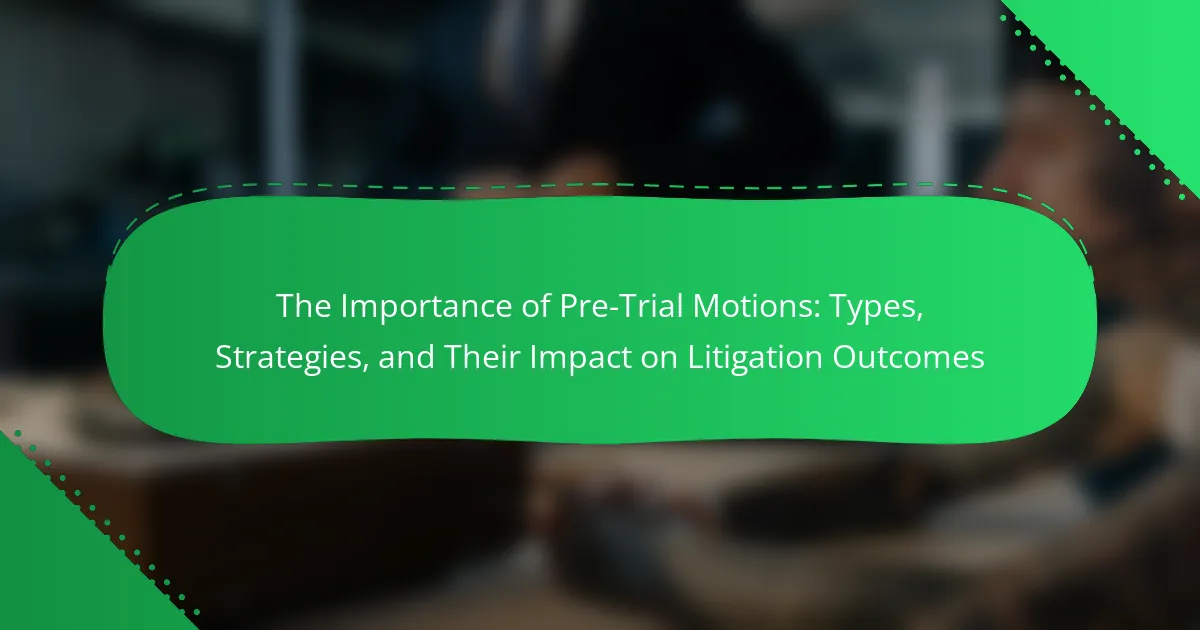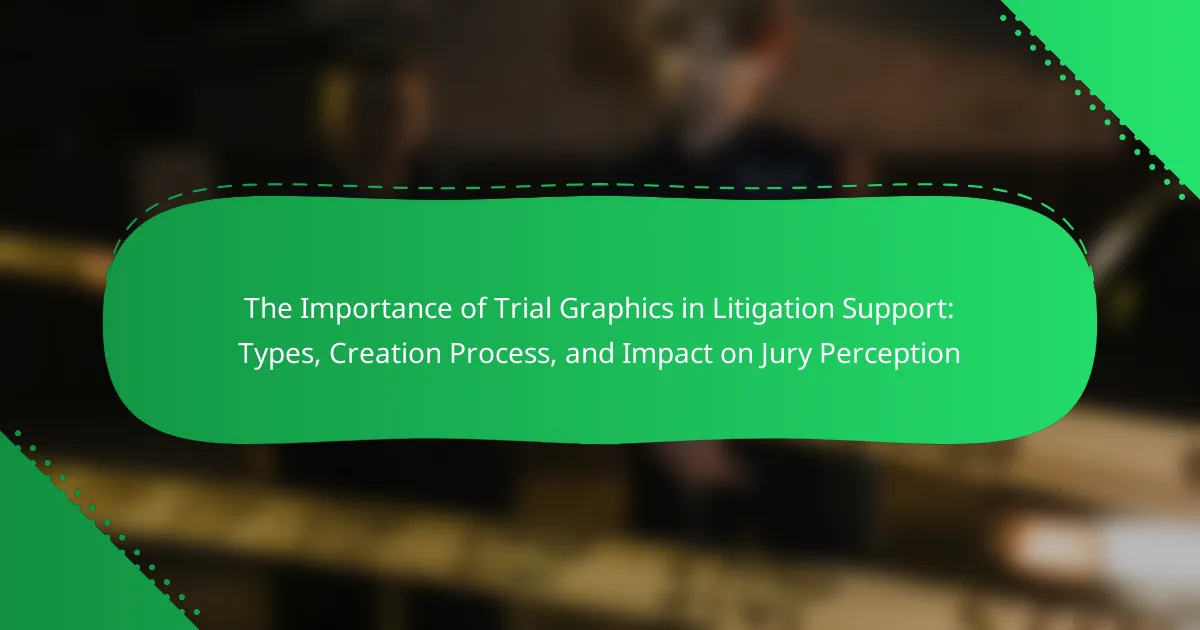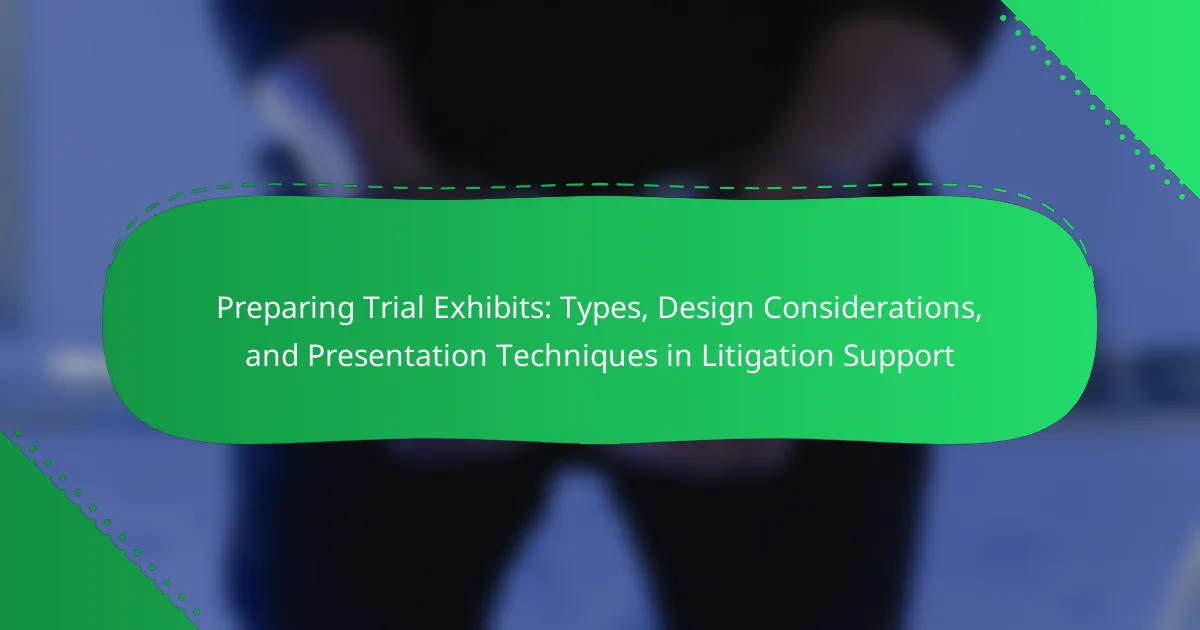Pre-trial motions are formal requests made to the court before a trial begins, playing a critical role in shaping litigation outcomes. This article examines the various types of pre-trial motions, including motions to dismiss, summary judgment motions, discovery motions, evidentiary motions, and motions in limine. Each type serves distinct strategies to streamline the trial process, influence evidence presentation, and potentially resolve cases before reaching trial. The importance of these motions is highlighted by their ability to clarify legal issues, save resources, and set legal precedents, with studies indicating that a significant percentage of civil cases are resolved through such motions. Overall, understanding pre-trial motions is essential for effective litigation strategy and achieving favorable outcomes.

What are Pre-Trial Motions and Why are They Important?
Pre-trial motions are formal requests made to the court before a trial begins. These motions can address various issues, such as dismissing a case or excluding evidence. They are important because they can significantly influence the direction and outcome of litigation. For instance, a successful motion to dismiss can end a case early, saving time and resources. Additionally, pre-trial motions can shape the evidence presented at trial, impacting jury perceptions. According to the American Bar Association, these motions are crucial for clarifying legal issues and ensuring fair trials.
How do Pre-Trial Motions influence the litigation process?
Pre-trial motions significantly influence the litigation process by shaping the issues to be resolved. These motions can determine the admissibility of evidence, which directly impacts trial strategies. For example, a motion to suppress evidence may exclude crucial information from the trial. This exclusion can weaken or strengthen a party’s case. Additionally, pre-trial motions can resolve legal issues before trial, saving time and resources. They can also lead to settlements by clarifying the strengths and weaknesses of each side’s position. According to the Federal Rules of Civil Procedure, many motions must be filed before the trial begins, emphasizing their importance in the litigation timeline.
What role do Pre-Trial Motions play in shaping case outcomes?
Pre-trial motions play a crucial role in shaping case outcomes. They can determine the admissibility of evidence, influence the legal standards applied, and even lead to case dismissals. For instance, motions to suppress evidence can exclude critical information, weakening the opposing party’s case. Additionally, summary judgment motions can resolve cases without a trial if there are no genuine disputes of material fact. Research shows that approximately 30% of cases are resolved through pre-trial motions, highlighting their significance in litigation. Overall, pre-trial motions can significantly impact the trajectory and resolution of legal disputes.
How can Pre-Trial Motions affect trial strategies?
Pre-trial motions significantly influence trial strategies by shaping the legal landscape before the trial begins. These motions can determine the admissibility of evidence, which directly impacts the arguments presented in court. For example, a successful motion to suppress evidence can weaken the opposing party’s case. Additionally, pre-trial motions can clarify legal issues, allowing attorneys to focus on the most pertinent arguments during the trial. They can also lead to settlements by revealing weaknesses in a case, prompting parties to negotiate. Furthermore, strategic use of pre-trial motions can establish the narrative framework for the trial, guiding how each side presents their case. Ultimately, the outcomes of these motions can dictate trial tactics, resource allocation, and overall litigation strategy.
What are the different types of Pre-Trial Motions?
Pre-trial motions are legal requests made before a trial begins. They aim to resolve specific issues or set the stage for trial proceedings. Common types of pre-trial motions include motions to dismiss, motions for summary judgment, and motions in limine.
A motion to dismiss challenges the legal sufficiency of a case. It can be based on various grounds, such as lack of jurisdiction or failure to state a claim. A motion for summary judgment seeks to resolve a case without a trial. It asserts that there are no genuine disputes over material facts.
Motions in limine address the admissibility of evidence before it is presented in court. These motions help prevent prejudicial or irrelevant information from influencing the jury. Other types include motions to compel discovery and motions for a change of venue. Each motion serves a distinct purpose in shaping the litigation process.
What is a Motion to Dismiss and when is it used?
A Motion to Dismiss is a legal request to terminate a case without a trial. It is used when the opposing party believes that the complaint lacks legal merit. Common grounds for this motion include insufficient evidence or failure to state a claim. The motion asserts that even if all allegations are true, there is no legal basis for the lawsuit. Courts evaluate these motions based on the complaint’s content. If granted, the case is dismissed, potentially saving time and resources. This motion is often filed early in the litigation process. It is a strategic tool to challenge the validity of claims before proceeding to trial.
How does a Motion for Summary Judgment function?
A Motion for Summary Judgment functions as a legal request to resolve a case without a trial. It asserts that there are no genuine disputes of material fact. This motion is typically filed after discovery is completed. The moving party presents evidence to support their claim. This evidence may include affidavits, documents, and depositions. The opposing party then has the opportunity to respond. The court reviews the evidence to determine if a trial is necessary. If the court finds no factual disputes, it may grant the motion, leading to a judgment in favor of the moving party. This process streamlines litigation and can significantly reduce court time and resources.
What are evidentiary motions and why are they significant?
Evidentiary motions are requests made to a court to admit or exclude specific evidence during a trial. They are significant because they can influence the outcome of a case by determining what information the jury or judge can consider. These motions help ensure that only relevant and admissible evidence is presented. For example, a motion in limine seeks to prevent certain evidence from being introduced based on legal standards. Courts evaluate these motions based on rules of evidence, such as relevance and prejudicial impact. Successful evidentiary motions can strengthen a party’s case or weaken the opponent’s position. Thus, they play a crucial role in shaping the litigation process and its results.

What strategies can be employed with Pre-Trial Motions?
Pre-trial motions can employ several strategies to enhance litigation outcomes. First, attorneys can use motions to dismiss to eliminate weak claims early. This saves time and resources. Second, summary judgment motions can be filed to resolve cases without a trial. This is effective when there are no material facts in dispute. Third, discovery motions can compel the opposing party to produce evidence. This ensures all relevant information is available for trial preparation. Fourth, evidentiary motions can challenge the admissibility of certain evidence. This can shape the trial’s narrative significantly. Lastly, motions in limine can prevent prejudicial information from being presented to the jury. These strategies collectively aim to streamline the trial process and improve the chances of a favorable outcome.
How can attorneys effectively leverage Pre-Trial Motions?
Attorneys can effectively leverage pre-trial motions by strategically using them to shape the litigation process. Pre-trial motions can be employed to dismiss cases, limit evidence, or compel discovery. These motions can streamline the trial by resolving issues beforehand. For example, a motion to dismiss can eliminate weak claims early, saving time and resources. Additionally, motions in limine can exclude prejudicial evidence, ensuring a fair trial. Statistics show that cases with pre-trial motions often have higher settlement rates. Thus, attorneys who utilize these motions can enhance their clients’ positions significantly.
What factors should be considered when drafting a Pre-Trial Motion?
Key factors to consider when drafting a Pre-Trial Motion include the legal basis for the motion, the relevant facts of the case, and the desired outcome. The legal basis must be supported by statutes or case law. Relevant facts should be clearly articulated and substantiated with evidence. The desired outcome should specify what relief or ruling is being sought. Timing is also crucial; motions must be filed within specific deadlines. Additionally, the potential impact on the case strategy should be evaluated. Consideration of opposing counsel’s likely responses is essential. Lastly, clarity and precision in language can enhance the motion’s effectiveness.
How can timing impact the effectiveness of Pre-Trial Motions?
Timing significantly impacts the effectiveness of pre-trial motions. Filing motions too early may lead to them being dismissed due to lack of sufficient evidence. Conversely, filing too late can result in missed opportunities to shape the trial. Courts often favor timely motions that allow for adequate consideration. For example, if a motion to dismiss is filed after substantial discovery, the court may view it unfavorably. Additionally, strategic timing can maximize the potential for settlement discussions. Effective timing aligns with the court’s schedule and procedural rules, enhancing the likelihood of success.
What common pitfalls should be avoided in Pre-Trial Motions?
Common pitfalls to avoid in pre-trial motions include lack of specificity in arguments. Vague claims can weaken the motion’s impact. Another pitfall is missing deadlines for filing motions. Timeliness is crucial in litigation. Failing to cite relevant case law can also undermine a motion. Courts expect legal precedents to support arguments. Additionally, neglecting to address opposing arguments can leave motions vulnerable. Anticipating counterarguments strengthens a position. Lastly, submitting poorly drafted documents can lead to dismissal. Clarity and professionalism are essential in legal submissions.
How can improper filing affect the outcome of a case?
Improper filing can significantly affect the outcome of a case by leading to dismissals or delays. Courts require strict adherence to filing procedures. Failure to follow these procedures can result in the rejection of crucial documents. For example, missing deadlines can bar a party from presenting evidence. Additionally, improper formatting may cause confusion about the claims being made. This confusion can undermine the credibility of the filing party. In some instances, it can even lead to sanctions from the court. Such outcomes highlight the necessity of proper filing in legal proceedings.
What mistakes do attorneys frequently make with Pre-Trial Motions?
Attorneys frequently make several mistakes with pre-trial motions. One common error is failing to research relevant case law. This oversight can lead to weak arguments. Another mistake is missing deadlines for filing motions. Timeliness is crucial in litigation. Additionally, attorneys may not adequately support their motions with evidence. This lack of support can weaken their position. Some attorneys also use overly complex language. Clarity is essential for judges to understand the arguments. Lastly, failing to anticipate counterarguments can leave motions vulnerable. Understanding these mistakes can improve the effectiveness of pre-trial motions.

What is the overall impact of Pre-Trial Motions on litigation outcomes?
Pre-trial motions significantly influence litigation outcomes by shaping the scope and direction of a case. They can lead to the dismissal of claims or defenses, which alters the case’s trajectory. Successful pre-trial motions often limit the issues for trial, streamlining the litigation process. They can also compel the opposing party to disclose evidence, impacting the overall strategy. According to a study by the Federal Judicial Center, approximately 60% of civil cases are resolved through motions before trial. This statistic underscores the importance of pre-trial motions in achieving favorable outcomes. Additionally, pre-trial motions can set legal precedents that influence future cases. Thus, their impact on litigation outcomes is profound and multifaceted.
How do Pre-Trial Motions contribute to case resolution?
Pre-trial motions significantly contribute to case resolution by streamlining legal proceedings. They allow parties to resolve issues before trial, which can lead to settlements. Common motions include motions to dismiss and motions for summary judgment. These motions clarify the legal landscape, helping to identify key facts and legal standards. By addressing these issues early, parties can avoid lengthy trials. This efficiency saves time and resources for both the court and the involved parties. Ultimately, pre-trial motions can lead to quicker resolutions, reducing the burden on the judicial system.
What statistics support the effectiveness of Pre-Trial Motions?
Statistics indicate that pre-trial motions significantly influence litigation outcomes. Research shows that approximately 30% of criminal cases are resolved through pre-trial motions. In civil cases, motions to dismiss can lead to a dismissal rate of about 20%. A study published in the Journal of Legal Studies found that successful pre-trial motions can reduce trial duration by 40%. Furthermore, data from the National Center for State Courts reveals that cases with pre-trial motions are 50% more likely to settle before trial. These statistics underscore the strategic importance of pre-trial motions in legal proceedings.
How do successful Pre-Trial Motions influence settlement negotiations?
Successful pre-trial motions can significantly influence settlement negotiations. These motions often clarify legal issues and evidence, shaping the case’s perceived strength. A successful motion may lead to favorable rulings that strengthen a party’s position. This can create leverage in negotiations, making settlement more appealing to the opposing party. Statistics show that cases with successful pre-trial motions often settle more favorably for the winning party. Additionally, the costs associated with continued litigation may prompt a settlement after a successful motion. Ultimately, successful pre-trial motions can shift the dynamics of negotiation, encouraging resolution before trial.
What best practices should be followed for effective Pre-Trial Motions?
Effective pre-trial motions should be clear, concise, and well-supported by evidence. Draft motions should outline legal grounds and relevant facts. Each motion must comply with court rules and deadlines. Supporting documents should be organized and submitted timely. Oral arguments should be prepared thoroughly, anticipating counterarguments. Collaboration with co-counsel can enhance the motion’s strength. Researching case law strengthens the legal basis of the motion. Effective pre-trial motions can significantly influence litigation outcomes by shaping the trial’s direction.
What tips can enhance the success rate of Pre-Trial Motions?
Thorough legal research enhances the success rate of pre-trial motions. Comprehensive understanding of relevant laws and precedents supports arguments effectively. Crafting clear and concise motions is essential. Clarity helps judges grasp the main points quickly. Including strong supporting evidence strengthens the motion’s position. Evidence must be relevant and compelling to persuade the court. Anticipating opposing arguments allows for better counterarguments. Addressing potential weaknesses in advance demonstrates preparedness. Finally, adhering to court rules and deadlines is crucial. Compliance ensures motions are considered valid and timely.
How can attorneys ensure compliance with procedural rules in Pre-Trial Motions?
Attorneys can ensure compliance with procedural rules in Pre-Trial Motions by meticulously reviewing applicable rules and guidelines. They should familiarize themselves with local court rules and federal regulations. This includes understanding deadlines for filing motions and required formats. Attorneys must also prepare clear and concise arguments that adhere to these rules. Additionally, they should maintain thorough documentation of all communications and filings. Regularly consulting with colleagues or legal mentors can provide further insights. Utilizing checklists can help attorneys track compliance steps effectively. By implementing these practices, attorneys can minimize the risk of procedural errors and enhance the chances of favorable outcomes.
The main entity of the article is Pre-Trial Motions, which are formal requests made to the court before a trial that can significantly influence litigation outcomes. The article outlines the various types of pre-trial motions, including motions to dismiss, motions for summary judgment, and evidentiary motions, and discusses their strategic importance in shaping trial strategies and case resolutions. It highlights how these motions can streamline the litigation process, impact the admissibility of evidence, and lead to settlements, while also providing best practices for attorneys to enhance the effectiveness of their motions. Additionally, the article presents statistical data supporting the effectiveness of pre-trial motions in achieving favorable outcomes in legal disputes.



